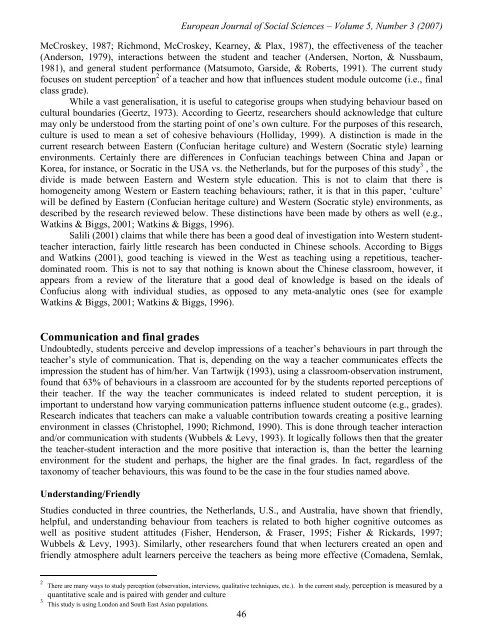european journal of social sciences issn: 1450-2267 - EuroJournals
european journal of social sciences issn: 1450-2267 - EuroJournals
european journal of social sciences issn: 1450-2267 - EuroJournals
You also want an ePaper? Increase the reach of your titles
YUMPU automatically turns print PDFs into web optimized ePapers that Google loves.
European Journal <strong>of</strong> Social Sciences – Volume 5, Number 3 (2007)<br />
McCroskey, 1987; Richmond, McCroskey, Kearney, & Plax, 1987), the effectiveness <strong>of</strong> the teacher<br />
(Anderson, 1979), interactions between the student and teacher (Andersen, Norton, & Nussbaum,<br />
1981), and general student performance (Matsumoto, Garside, & Roberts, 1991). The current study<br />
focuses on student perception 2 <strong>of</strong> a teacher and how that influences student module outcome (i.e., final<br />
class grade).<br />
While a vast generalisation, it is useful to categorise groups when studying behaviour based on<br />
cultural boundaries (Geertz, 1973). According to Geertz, researchers should acknowledge that culture<br />
may only be understood from the starting point <strong>of</strong> one’s own culture. For the purposes <strong>of</strong> this research,<br />
culture is used to mean a set <strong>of</strong> cohesive behaviours (Holliday, 1999). A distinction is made in the<br />
current research between Eastern (Confucian heritage culture) and Western (Socratic style) learning<br />
environments. Certainly there are differences in Confucian teachings between China and Japan or<br />
Korea, for instance, or Socratic in the USA vs. the Netherlands, but for the purposes <strong>of</strong> this study 3 , the<br />
divide is made between Eastern and Western style education. This is not to claim that there is<br />
homogeneity among Western or Eastern teaching behaviours; rather, it is that in this paper, ‘culture’<br />
will be defined by Eastern (Confucian heritage culture) and Western (Socratic style) environments, as<br />
described by the research reviewed below. These distinctions have been made by others as well (e.g.,<br />
Watkins & Biggs, 2001; Watkins & Biggs, 1996).<br />
Salili (2001) claims that while there has been a good deal <strong>of</strong> investigation into Western studentteacher<br />
interaction, fairly little research has been conducted in Chinese schools. According to Biggs<br />
and Watkins (2001), good teaching is viewed in the West as teaching using a repetitious, teacherdominated<br />
room. This is not to say that nothing is known about the Chinese classroom, however, it<br />
appears from a review <strong>of</strong> the literature that a good deal <strong>of</strong> knowledge is based on the ideals <strong>of</strong><br />
Confucius along with individual studies, as opposed to any meta-analytic ones (see for example<br />
Watkins & Biggs, 2001; Watkins & Biggs, 1996).<br />
Communication and final grades<br />
Undoubtedly, students perceive and develop impressions <strong>of</strong> a teacher’s behaviours in part through the<br />
teacher’s style <strong>of</strong> communication. That is, depending on the way a teacher communicates effects the<br />
impression the student has <strong>of</strong> him/her. Van Tartwijk (1993), using a classroom-observation instrument,<br />
found that 63% <strong>of</strong> behaviours in a classroom are accounted for by the students reported perceptions <strong>of</strong><br />
their teacher. If the way the teacher communicates is indeed related to student perception, it is<br />
important to understand how varying communication patterns influence student outcome (e.g., grades).<br />
Research indicates that teachers can make a valuable contribution towards creating a positive learning<br />
environment in classes (Christophel, 1990; Richmond, 1990). This is done through teacher interaction<br />
and/or communication with students (Wubbels & Levy, 1993). It logically follows then that the greater<br />
the teacher-student interaction and the more positive that interaction is, than the better the learning<br />
environment for the student and perhaps, the higher are the final grades. In fact, regardless <strong>of</strong> the<br />
taxonomy <strong>of</strong> teacher behaviours, this was found to be the case in the four studies named above.<br />
Understanding/Friendly<br />
Studies conducted in three countries, the Netherlands, U.S., and Australia, have shown that friendly,<br />
helpful, and understanding behaviour from teachers is related to both higher cognitive outcomes as<br />
well as positive student attitudes (Fisher, Henderson, & Fraser, 1995; Fisher & Rickards, 1997;<br />
Wubbels & Levy, 1993). Similarly, other researchers found that when lecturers created an open and<br />
friendly atmosphere adult learners perceive the teachers as being more effective (Comadena, Semlak,<br />
2 There are many ways to study perception (observation, interviews, qualitative techniques, etc.). In the current study, perception is measured by a<br />
quantitative scale and is paired with gender and culture<br />
3 This study is using London and South East Asian populations.<br />
46

















